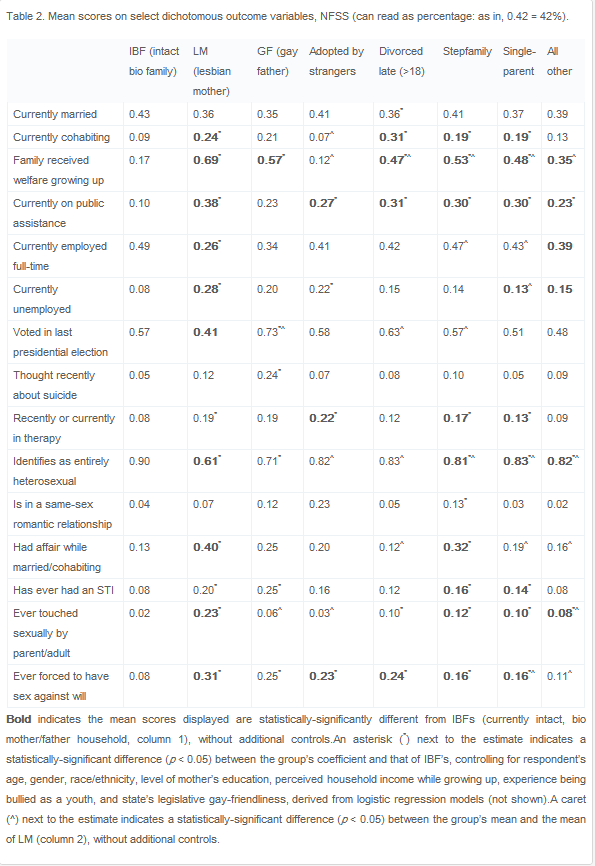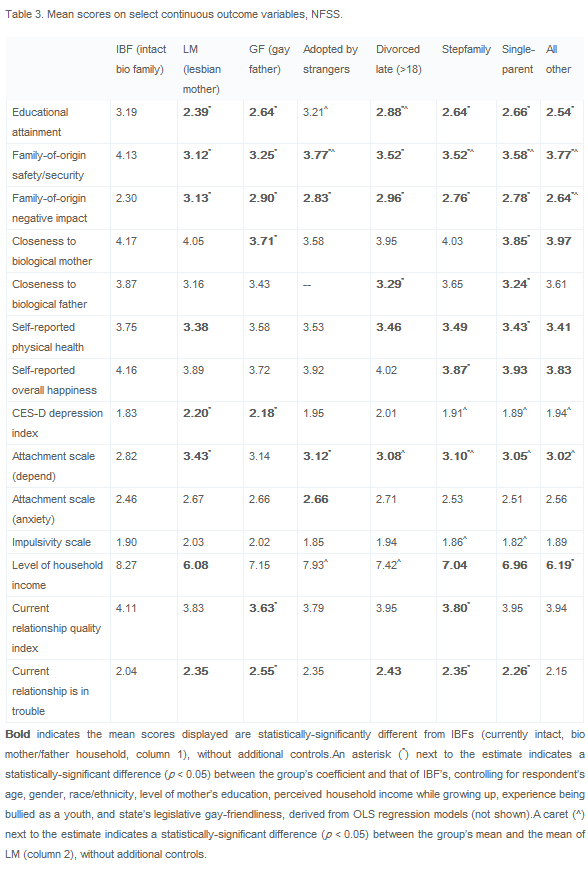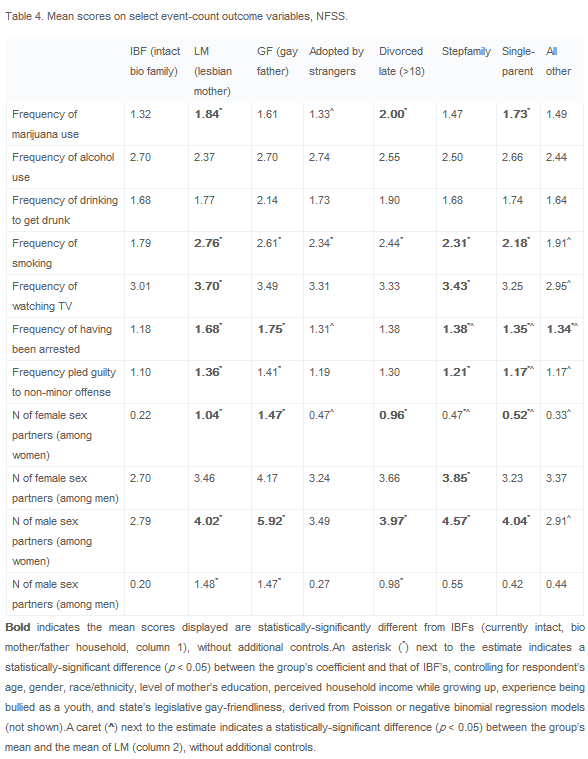The Regenerus “Gay Parenting” Study
 I’m starting to get into the habit of leaving big blogging subjects alone for a week or so, partly so I can reflect on what I want to write and partly just because I don’t have the time these days to do decent blogging every day. However, given that some of the dust has now settled on this subject and that position lines have been clearly drawn, permit this personally involved in the debate statistician a few thoughts.
I’m starting to get into the habit of leaving big blogging subjects alone for a week or so, partly so I can reflect on what I want to write and partly just because I don’t have the time these days to do decent blogging every day. However, given that some of the dust has now settled on this subject and that position lines have been clearly drawn, permit this personally involved in the debate statistician a few thoughts.
The bottom line is this – the research is not as flawed as the critics claim and it does not quite deliver the killer blow that advocates might wish it to.
Let’s summarise the paper. Regenerus used data from the New Family Structures Survey to explore parenting outcomes for different young adults, looking specifically at any differences between those who grew up to maturity with their biological family intact (i.e. they got to the age of majority with the parents who sired them still together as a family unit) and those who grew up with one or more parents who had been in a same-sex relationship. Of course, as we will discuss below, it is the definition of “in a same-sex relationship” which has drawn huge criticism.
The use of the NFSS database makes this piece of research far superior to every single piece of research on the subject before. This is not a statement I make lightly, but the advantage of this data-set is that instead of it being a collection of people who are recruited to engage in “gay parenting” studies (a practice which lends itself towards what we call “selection bias“). Up to this point there has been no survey on this subject that has not been guilty of being flawed in this manner (though I am open to being pointed to a study on the subject which had a randomised sample – feel free to comment below with a URL) or has had sample sizes that were so small that statistically significant differences were next to impossible to discern. Until the Regenerus research.
The results of the survey are staggering. Regenerus split the NFSS sample into eight groups to explore the differences between them. He describes the splits as follows.
For this particular study, I compare outcomes across eight different types of family-of-origin structure and/or experience. They were constructed from the answers to several questions both in the screener survey and the full survey. It should be noted, however, that their construction reflects an unusual combination of interests—the same-sex romantic behavior of parents, and the experience of household stability or disruption. The eight groups or household settings (with an acronym or short descriptive title) evaluated here, followed by their maximum unweighted analytic sample size, are:
- IBF: Lived in intact biological family (with mother and father) from 0 to 18, and parents are still married at present (NÂ =Â 919).
- LM: R reported R’s mother had a same-sex romantic (lesbian) relationship with a woman, regardless of any other household transitions (N = 163).
- GF: R reported R’s father had a same-sex romantic (gay) relationship with a man, regardless of any other household transitions (N = 73).
- Adopted: R was adopted by one or two strangers at birth or before age 2 (NÂ =Â 101).
- Divorced later or had joint custody: R reported living with biological mother and father from birth to age 18, but parents are not married at present (NÂ =Â 116).
- Stepfamily: Biological parents were either never married or else divorced, and R’s primary custodial parent was married to someone else before R turned 18 (N = 394).
- Single parent: Biological parents were either never married or else divorced, and R’s primary custodial parent did not marry (or remarry) before R turned 18 (N = 816).
- All others: Includes all other family structure/event combinations, such as respondents with a deceased parent (NÂ =Â 406).
Together these eight groups account for the entire NFSS sample. These eight groups are largely, but not entirely, mutually exclusive in reality. That is, a small minority of respondents might fit more than one group. I have, however, forced their mutual exclusivity here for analytic purposes. For example, a respondent whose mother had a same-sex relationship might also qualify in Group 5 or Group 7, but in this case my analytical interest is in maximizing the sample size of Groups 2 and 3 so the respondent would be placed in Group 2 (LMs). Since Group 3 (GFs) is the smallest and most difficult to locate randomly in the population, its composition trumped that of others, even LMs. (There were 12 cases of respondents who reported both a mother and a father having a same-sex relationship; all are analyzed here as GFs, after ancillary analyses revealed comparable exposure to both their mother and father).
Now, there are issues with the way Regenerus has performed this split, but we will return to them once we review the outcomes Regenerus found.
Here’s the first table.
OK, how do you read this table? On the left hand side you have an attribute for the young adult (20s or 30s), say for example “Currently Married”. Read across and for each of the different parenting backgrounds you can see the percentage likelihood the young adult will have that outcome. So to use our “Current Married” example, young adults who grew up in an IBF family (Intact Biological Family) are 43% likely to be married today whereas those who grew up with a single parent are only 37% likely to be married today (a 6% difference).
With it so far? Now things get a bit more complicated. Yes, on average IBF kids are 43% likely to be married and single parenting kids 37% likely, but given that this is just a sample rather than asking every single IBF kid whether they are now married, in reality the true figure might be above or below 43%. We have statistical measures called standard deviations which help us work out these boundaries. The rough rule of thumb is that when we get a sample result like this, we reckon the true value for the whole population (not just the sample we questioned) lies within 2 standard deviations either side of the mean. So in the IBF “now married” example above, if the  standard deviation is 0.02, that means we reckon that the true value for the whole population lies somewhere between 39% and 47%, but it’s probably most likely nearer 43%.
If we have two results where these two boundaries cross, we say that we’re not certain that there is a real difference between the results. For example, lets assume above that the Single Parent result also has a standard deviation of 0.02. That means that the top boundary of the range of the “true” result for single parenting goes up to 0.41. However, we already saw that the lower bound for IBF families falls to 0.39 (39%) so the lower and upper boundaries of the IBF and single parent family respectively cross over each other. In this case we cannot be sure that the difference in average results (0.43 to 0.37) is a real difference so we can’t say that the research proves such a difference.
This is exactly the case in the research above – although we don’t have the SD for each result, the table does tell us where differences are statistically significant. In the table above Regenerus has marked in bold all the results where a differing parenting background produces a statistically significant difference to a young adult raised in an IBF. But Regenerus went further than this. In response to the claim that kids of gay parents might have been bullied and this rather than their parenting led to their different adult outcomes, he controlled for this and other factors (family income, whether the State the kids grew up in had civil union legislation, age, race, gender etc) in order to remove the possibility of that interpretation. So in the table above you can see both outcomes which are statistically different from IBF (in bold) and statistically different when controlling for other external factors (with an asterix). Our “best results” are therefore where we see a bold figure with an asterix next to it.
Comparing IBF to LM / GF groups we see key differences in the areas of sexual identity, marital/relationship fidelity and sexual abuse. Interestingly these differences seem most likely when the same-sex active parent is a lesbian, which goes against some of the previous research (for example the research on those in civil unions examined here). These differences continue in the next two tables of results.
Here we see clear differences in the young adults growing up in LM and GF households compared to IBF young adults in the areas of educational attainment, feelings of security, feeling that their family environment harmed them, depression and the quality of their current relationship.
What is most interesting in the third table is the massive increase in same-sex and other-sex sexual partners amongst the female children of gay parents and same-sex partners for male children. There is nothing in the data of course to suggest whether this is “inherited homosexuality” in a biological / genetic sense or whether it identifies how growing up in a same-sex household makes one more likely to choose to identify in the same manner.
Here are Regenerus’ conclusions,
Just how different are the adult children of men and women who pursue same-sex romantic (i.e., gay and lesbian) relationships, when evaluated using population-based estimates from a random sample? The answer, as might be expected, depends on to whom you compare them. When compared with children who grew up in biologically (still) intact, mother–father families, the children of women who reported a same-sex relationship look markedly different on numerous outcomes, including many that are obviously suboptimal (such as education, depression, employment status, or marijuana use). On 25 of 40 outcomes (or 63%) evaluated here, there are bivariate statistically-significant (p < 0.05) differences between children from still-intact, mother/father families and those whose mother reported a lesbian relationship. On 11 of 40 outcomes (or 28%) evaluated here, there are bivariate statistically-significant (p < 0.05) differences between children from still-intact, mother/father families and those whose father reported a gay relationship. Hence, there are differences in both comparisons, but there are many more differences by any method of analysis in comparisons between young-adult children of IBFs and LMs than between IBFs and GFs.
While the NFSS may best capture what might be called an “earlier generation†of children of same-sex parents, and includes among them many who witnessed a failed heterosexual union, the basic statistical comparisons between this group and those of others, especially biologically-intact, mother/father families, suggests that notable differences on many outcomes do in fact exist. This is inconsistent with claims of “no differences†generated by studies that have commonly employed far more narrow samples than this one.
Here’s a full interview with Regenerus on the paper.
The one major criticism that has been raised against the research is that the terms “Lesbian Mother” and “Gay Father” in this research cover a number of different situations. Here’s one example from Cynthia Osborne, of the University of Texas LBJ School of Public Affairs, featured on BTB,
To increase the sample size of children who experienced a same-sex parent, Regnerus included respondents in either the LM or GF comparison groups if they reported that their parent ever had a same-sex relationship. Although this decision has a lot of merit, it makes comparisons across groups somewhat of a challenge. Because the LM group is comprised of young adults who experienced multiple family forms and transitions, it is impossible to isolate the effects of living with a lesbian mother from experiencing divorce, remarriage, or living with a single parent.
Well yes, but the sample size is the best random sample we have at the moment. An an interview responding to some of the criticism Regenerus suggested that other researchers examine the full data-set when it becomes publicly available after the summer, and that they also explore the differences within the “Lesbian Mother” and “Gay Father” groups, sample size permitting. But it’s important to note that just because all those parents with some form of same-sex relationship (whether short-term or life-long) have been put together, that does not mean that the data is useless. We do the same thing all the time in social research when sample sizes would be too small otherwise. It is the paucity of gay families in the large NFSS sample that is the issue here. The Regenerus research cannot be used to argue that all gay parents per se produce poor outcomes for their children and neither crucially can it be used to argue that specifically gay parents in long-term monogamous relationships produce poorer outcomes for their children.
But what the data does tell us is that children of parents, where one or more of those biological parents has a same-sex relationship whilst they were growing up, do have poorer outcomes and in some cases severely poorer outcomes. That sample group of “had a same-sex relationship” includes long-term monogamous gay unions because to separate them out would leave too small sample sizes, so we in some senses have to go with what we’ve got. Within the LM and GF groups there will be significant variances but, and this is absolutely crucial, we cannot with any reliability claim what those variances are without the further research Regenerus is calling for. It is not an acceptable critique to argue that a sub-sample contains sub-sub-samples which have different outcomes without providing the statistical evidence of such different outcomes. Simply put, monogamous gay parents may have different parenting outcomes to promiscuous gay parents, but without the data to support such an hypothesis it remains an unproven hypothesis.
In conclusion, what we have is probably the best research on “gay parenting” ever produced (and certainly better than the overwhelming majority of previous studies on the subject which often demonstrate extraordinary selection bias) which itself raises some more questions. Can we drill down into the LM and GF groups to explore in greater detail whether monogamy does change parenting outcomes? Is the lack of long-term monogamous gay families itself in the data sample a “result” which needs to be examined (the data set found only two gay families which had been together for 18 years)? Perhaps most interestingly, does this research based on young adults who are now in their 20s and 30s say about gay families today, where kids grow up in far more gay-friendly environments and where children in gay families are far more often planned by the two gay parents rather than “inherited” from previous heterosexual unions?
Your thoughts?



I wonder what would be thrown up if heterosexual parenting was submitted to an equally sustained and probing study. We all know there are good parents but there are also sadly some very bad ones, some of whom murder their children. I really am not sure what this kind of study sets out to prove except that “homosexual parenting is worse than heterosexual parenting” so in that sense it begs the question. Until the children reach well into their adulthood and their lives can be examined retrospectively how can anyone predict outcomes? It is really all too new to say so the only valid objection might be that it is wrong to experiment with traditional family set-ups….except that the ideal traditional family has often been more honoured in the breach rather than the observance.
To be fair to the study, it’s not about parenting per se but outcomes of adult children from different parenting set-ups. Some of what you ask for is there – the split between IBF, single parents, divorced and widowed parents etc.
It has to be pointed out again and again that the grouping together of all kinds of different families under the LM and GF groups is not ideal, but it is remarkably better than anything that has come before because it is a randomised sample – the very thing that those criticising other studies (eg Spitzer or J&Y) call for.
The problem that most of the critical commentary I’ve seen so far focuses on is the wide definition of ‘gay parent’ to include anyone with some sort of same sex experience. And when I first saw the report, it did strike me as odd methodologically.
But having thought about it, the methodology can be justified not only on the grounds of necessity as you do above -ie it’s the best random sample we available have just now- but also on the ground that it’s precisely the right response to a very vague claim that’s actually being made. In general, the claim we’re often being asked to consider now in society is that ‘there are very few differences of note in the child outcomes of gay and lesbian parents’ (report, 1.0). Now that claim is itself incredibly vague. Quite apart from issues of identity (when exactly are you gay/lesbian), it’s also vague about the nature of parenthood (biological, foster, planned, inherited from a heterosexual relationship etc). So it’s a bad foundation on which to conduct a reasoned debate. But given that it is the claim, it’s important that the evidence, so far as it exists, now suggests that there are in fact significant differences of note.
This of course suggests the need for further research and for the need (as you say) to drill down into the sub-groups making up ‘gay and lesbian parents’. But this does put the burden of proof on those who would identify this or that sub group of gay/lesbian parents as particularly effective to a) show some evidence for this claim and b) to be much clearer about why that sub group (rather than any other) should be the one to focus on and precisely what claim is being made about it and its outcomes.
Spot on. The survey answers the basic question quite clearly and invites further investigation to clarify sub-sets and their different performance.
See this critique:
http://www.huffingtonpost.com/debra-umberson/texas-professors-gay-research_b_1628988.html
Appallingly shallow. This “critique” admits that the sample sizes to do the kind of research it wants were unavailable and then completely ignores Regenerus’ own comments that the the Lesbian Mother and Gay Father should not be used to suggest that the “ideal” gay families can be discounted by his research. In short, in sets up a straw man and then knocks it down, criticising something Regenerus never claimed.
The sample data will be out in the Autumn and at that point we will be able to see whether the “3+ years with LM or GF” sub-sample produces any significant results. Until then I repeat what I wrote above – it is up to critics to provide the randomised sub-samples they demand before they critique Regenerus for doing the best he could with the data available.